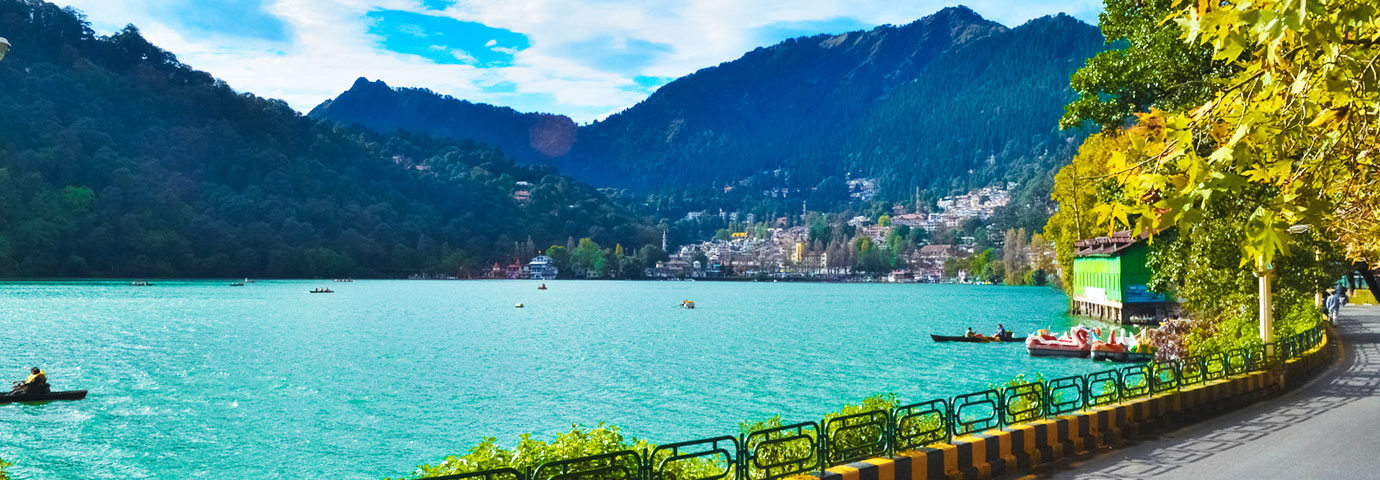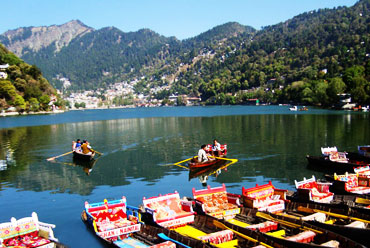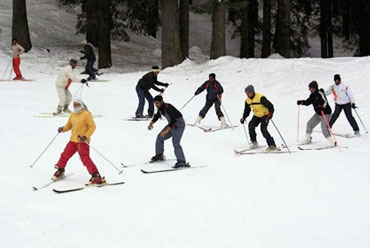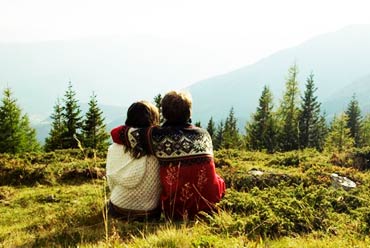The names of two Englishmen must always be linked with the discovery of the Lake at Nainital. One of them G. W. Traill, Commissioner of Kumaon and Garhwal, was the first European to set eyes on it in 1823. Nevertheless, the lake had been known for quite some time to herdsmen from villages nearby and held in great reverence as an abode of gods and spirits. Traill had great respect for the traditions and beliefs of the hill folk. To his way of thinking, crowds would violate the sanctity of the place, so he kept the discovery strictly to himself.
On the other hand, P. Barron, a trader in sugar from Shahjahanpur and an intrepid traveler, had no sooner caught a glimpse of the lake in its sylvan setting than he realized its potential as a hill resort and went full steam a colonizing it. The year was 1839. Barron first reached the lake through a trick, a fact mentioned in his book Wanderings in the Himmala. He knew there was a large lake in the heart of Kumaon. He also knew that local guides deliberately misled Europeans who wished to go there, in order to keep the location a secret. Sure enough, Barron's guide declared he had never heard of the lake, at which Barron placed on the guide's head a large stone and told him to carry it till they managed to find the lake. He said there were reputedly no stones near the lake and he needed come to build a house. Desperate to be rid of the load, the guide soon confessed he knew the lake well enough and there was no scarcity of stones in the general area. Barron says that other Europeans also resorted to the same trick till such time that Nainital found a place on the map.
On his second visit, Barron got the better of a local thokdar (village headman) Nar Singh who had laid claim to the lake and the surrounding hills as his ancestral property. The matter was pending settlement in court. Barron persuaded Nar Singh to accompany him for a ride on the lake in his (Barron's) own private boat, a rarity in those days.In the middle of the lake, Barron threatened to upset the boat if Nar Singh did not waive his claim, thereby admitting the right of the honorable Company Bahadur to the disputed land. Nar Singh had no choice for, unlike the others, he could not swim. He wrote the needful in pencil on the page of a pocketbook provided by Barron. Mission accomplished, Barron promptly applied for a plot to construct a house. Land was allotted for the purpose just above the present Nainital Club at an annual lease of two annas! Here, Barron constructed the house Pilgrim Lodge, his pen name being Pilgrim. The house stands to this day.
The sapphire-like Nainital Lake, surrounded by densely wooded hills and rich pastureland, the home of the tiger, leopard, ghoral and pheasant, appeared to P. Barron as "by far the most beautiful sight I have witnessed in the course of a fifteen hundred mile walk in the Himmala. The water is as clear as crystal! A beautiful little stream supplied from the springs of the overtopping mountain is continually running into it and a smaller one flowing out of it." The Nainital Lake and its environs have changed much since Barron made the above entry in his diary. However, the charm that initially bowled over all those who set eyes on it is still here. You come up the Kathgodam-Nainital highway, all excitement asking eagerly, Where's the lake? How much longer to the lake? And there, when you are least expecting it, the lake springs a delightful surprise! Green to its very depths, silvered by moon and sun and splashed with the cheerful colors of yachts and rowing boats, the Nainital Lake is an open invitation to a holiday.
History
No account of Nainital would be complete without reference to the terrible landslip of September 18, 1880, on the Sher-ka-Danda ridge. Before this catastrophe, it had rained steadily for four days, the rain soaking into the cracks in the ridge, making it unstable. Bang in the path of the slip stood the Hotel Victoria. Below it on the verge of the lake was the Naina Devi Temple. At about 10 AM on the fateful morning the first slip occurred, carrying away a portion of the outhouses and the western wing of the hotel. At about twenty past one, a large boulder from the cliff above came hurtling down. And in another ten minutes, the whole hillside seemed to erupt in one mass of semi-fluid matter that made a clean sweep of the hapless hotel. The dead and missing numbered 151. The Naina Devi temple was destroyed and later rebuilt on its present site. In itself a great disaster, the landslide nevertheless focused attention on the need for proper drainage around the hills of Nainital. It also literally created the flats. The rubble that fell choked one end of the lake and was later evened out to form a vast level stretch of ground, one of the assets of Nainital today.
Tourists Attractions
If you have a car at your disposal (for your sake we hope you don't, for that way you miss out on a lot that's very, very interesting), you can drive down the Mall from the entry point at Tallital (lower end) to Mallital (upper end of the lake). If you're lucky enough to be footing it, you take the side wall along the brim of the lake and pass under an extended canopy of the sun spangled leaves while images of poplar, cypress and willow gently ripple on the surface of the water to your left. To your right the hills take off again, rising from the edge of the Mall in one giant sweep of habitation. Nainital is studded with buildings-shops, restaurants, private homes, hotels and boarding houses. During the last decade or so, it has witnessed the emergence of mega hotels and the construction of houses by agencies as against private individuals. However, despite the commercialization, it's fun place, with so much to do there's never a dull moment.
You could of course go for a boat ride. The single-seater rowing boats are all gone but the larger double ones and pedal boats are aplenty and except in choppy weather, the ride is satin smooth. But take care, don't go boating when there's a mist on the lake and never change your seat midstream. For yachting enthusiasts there is a yacht club and temporary membership is available. Swimming used to be popular but the scope has been reduced by the presence of algae in the water.
At the Mallital end of the lake, you have the flats, a vast expanse of level ground, which in season is a cheerful colorful sea of humanity. One portion does duty as a car park, another houses an assortment of bazaars, notably the Tibetan market. At one end stand the Gurdwara and the Naina Devi temple complex. The spread of the flats offers a very welcome venue for sports events like football and hockey tournaments, held regularly every year.
At the mall end of the flats, you can pick up fresh seasonal fruit by the roadside-pink strawberries and clusters of garnet-hued mulberry, in tiny cane baskets, straight from Jeolikote on the Kathgodam-Nainital highway. Nainital has a long and thriving bazaar where you can shop for the whole range-designer clothes to shoes to books, curios and decorative candles. Candle making as a cottage industry has come to Nainital in a big way and retail outlets are dotted all over town. Latest in the line are the elegantly perfumed, iridescent candles that make light of power cuts.
Nevertheless, Nainital is an outdoor place, with a dozen or more picnic spots within easy reach. If you are not overfond of walking, you could hire a pony and clip-clop your way up. Seven hills surround the lake and provide excellent trekking. Ayarpatta, Deopatta, Handi Bandi, Cheena, Alma, Laria Kanta, and Sher-ka-Danda-goes the impressive roll of names. Cheena (Naina) Peak, at 8,568 feet-the tallest of all-commands a superb view of the Himalayas and an intriguing bird's-eye view of Nainital. Kilbury, the second highest, has a forest rest house that offers a quiet weekend. But snow view on the Sher-ka-Danda hill is the most easily accessible, if not on foot then via the cable car that skims its surface and whisks you away merrily to the top. Once there you can only gaze in wonder at the glittering panorama of Himalayan snows spanning the distant horizon. Tiffin Top (Dorothy's Seat) is every bit worth the climb. Land's End affords a charming view of the lake known as Khurpa Tal and the terraced hills surrounding it, while Hanuman Garhi, with its famous temple, is reputed for its glorious sunsets. Near the temple stands the Uttar Pradesh Government observatory and the Satellite Tracking Center.
Ayarpatta Hill is a haven of trees-oak, fir, deodar, pine and rhododendron. Some of the roads are narrow and still paved with brick. On this hill stands Gurney House, home of the great Jim Corbett, the fearless famous hunter, conservationist and writer to remember. The house was named after Corbett's father. It is now a museum of Corbett memorabilia-shikar trophies, fishing rods, books, writing desk and old moth-eaten maps of 'Nynee Tal'. For all those who love nature and admire Corbett's sensitivity to it, this is hallowed ground.
Nainital no longer enjoys the distinction of being the summer capital of Uttar Pradesh, but people come from all walks of life-short-stay tourists and those who spend the entire length of the season, be it April-June or September-October. Autumn is marked by a month long festival with a torchlight yacht procession, which, for sheer beauty, is incomparable. There is a hamper of fun with something for everyone: games and sports, a beauty contest, musical gatherings, plays and campfires. During the rainy season, Nainital is wrapped in mist and dotted with a million flowers. Lights twinkling through the mist give it the appearance of the never never land of fantasy. Winter at Nainital is great fun too, what with the sharp and bracing air, hotels begging for customers and all the facilities available at half rate. January and February bring overcast skies, intermittent rain and the eagerly awaited snow. They also thin out the crowds to make of Nainital a holidaymaker's paradise.
The Legendary Lake
The Nainital Lake finds mention in the Manas Khand (chapter) of the Skanda Purana (scriptures) as the Tririshi Sarovar, i.e., the lake of the three sages-Atri, Pulastya and Pulaha. Legend has it that in the course of their pilgrimage the three sages arrived here, only to find the place without water. Meditating on the sacred and bountiful Mansarovar Lake, they dug a hole here. So great was the power of their tapas (meditation) that the hole soon filled with water. The name Nainital is derived from an old temple of Goddess Naina Devi on the shore of the lake. The origin of the temple is shrouded in mystery. It is believed that Lord Shiva, gone berserk after the death of his consort Sati, strode the earth like a colossus, with Sati's half-charred body over one shoulder. As he passed over the lake, Sati's left eye dropped there. The place was sanctified as the home of the Goddess Naina Devi (from naina, meaning eye).
Places Around Nainital
Bhimtal You might say poplars have overrun Bhimtal. As you enter the little town, clouds of translucent sliver-green leaves wave you on and on, right to the southern end of the expansive lake. Bhimtal has oak forests too and the habitation is thick enough to permit wildlife to exist side by side-hill birds, chiefly the pheasant, serao, kakar, sambhar (varieties of deer), the occasional beer and leopard.
Bhimtal, 23 km from Nainital, is your place for a quiet holiday. It has lovely dappled paths, ravines festooned with dog rose and wild raspberry, farm houses set among terraced fields and citrus trees hung with galgal like so many golden balls. The lake offers scope for boating and many a home sports a brightly painted, private boat as well. In the middle of the lake, there is an intriguing looking island with a restaurant. The only thing that disturbs the peace is a gaggle of geese that has made the island its home.
Bhimtal has a large roomy, comfortable Tourist Bungalow with a grandstand view of the lake. The family cottages attached are particularly cosy and welcoming. The bazaar is an old time affairs, as quaint as could be, and for the more energetic tourist, there's a large up and coming industrial estate to explore.
Sat Tal If you are a fish fan, be sure to reach the tin-roofed Government fish depot at Sat Tal by 8 AM for your pick of carp. Spanking fresh, netted right there at the crack of dawn. However, Sat Tal has a lot more besides fish to recommend it. Originally a cluster of seven lakes, now reduced to five (since two have dried up), Sat Tal (21 km from Nainital) has all it takes to veil the place in a kind of mystique-densely wooded hills, roads that glide under a canopy of gossamer green oak trees, pines and dark brooding firs, little creeks along the shores of the lakes, boat rides on the placid waters, a log cabin that's sheer temptation.
A large part of Sat Tal is really the estate of the Methodist Church, South Asia branch. An ashram founded by the late Rev. Stanley Jones, evangelist, holds camp for young people every year. There is a small Tourist Bungalow, the above-mentioned log cabin and a string of country shops that cater to the needs of the day visitor. More important, there are birds around and occasionally a leopard makes its appearance. When evening falls, you can sit by the side of Ram-Lakshman Tal and ask the boatmen for ghost stories. They will be only too happy to oblige.
Naukutchia Tal This tal has nine corners. The local wag has it that anyone who manages to see all nine from a single vantage point will either drop dead or come into big money. A visitor may or may not have the nerve to test the truth of this prophecy but he will doubtless find this tree-fringed lake clean and inviting. Brightly painted towing and pedaling boats are available for hire at two points along the shores.
Naukutchia Tal (27 km from Nainital and 4 km from Bhimtal) earned a name as the home of Frederick Smetacek, the well-known naturalist who spent a few years here before moving on to Bhimtal. Originally a hunting lodge, the Smetacek home still stands by the Naukutchia Tal-a roomy, gracious looking structure set in an orchard of generous proportions.
How To Reach
Placed at an altitude of 2000 m above the sea level, Nainital is a beautiful hill town in the Uttarakhand state. A former British hill resort, it is set around the serene waters of Nainital Lake that has Naina Devi Hindu Temple on its northern banks. This is how to reach Nainital:
By Air
The nearest airport to Nainital is Pantnagar Airport, which is located at a distance of around 58 km from here. This airport is well-connected to the capital city of India, Delhi via regular flights. Rent a cab or board a bus to Nainital. The nearest international airport to Nainital is Indira Gandhi International Airport, Delhi that is around 315 km from here. From the airport, you can hire a taxi, hop into a bus, or go on-board a train.
By Train
The nearest railway station to Nainital is Kathgodham Railway Station, at the foothills of the Kumaon hills. The distance between the two is around 24 km. Kathgodam railway station has a good connectivity with important Indian destinations such as Howrah, Delhi, Dehradrun, Jammu, Kanpur, Jammu and Lucknow. From outside the railway station, you rent a cab or board a bus.
By Road
Nainital enjoys a good road connectivity to all the important destinations of northern India. State-run as well as private buses ply regularly. The other option is to rent a cab or self-drive.
Best time to visit Nainital
Nainital has been blessed with a wonderful climate and thus can be visited all year-round. April to June are the summer months when the days are pleasant for sightseeing and boating. The temperature remains between 10 degree Celsius and 25 degree Celsius but on some days, the heat can be harsh during the day.
As July comes, Nainital is drenched in rains and remains so till September. Sometimes it can rain all throughout the day. During July and September, there can be road blocks. However, the place becomes all the more beautiful. And, there are good discounts, during summer and monsoon months. October to March is the winter season in Nainital with chilly mornings and evenings and pleasant weather during the day. The place gets covered with mist and looks awesome. During extreme winters, there is occasional snowfall. Plan your visit accordingly.





